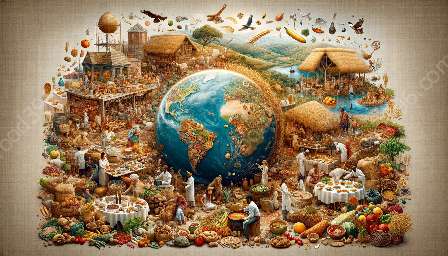Food preservation has played a crucial role in shaping human civilization and has deep connections to culinary history and traditional food systems. This timeless practice has enabled communities to extend the shelf life of perishable foods, ensuring sustenance during scarcity and contributing to cultural diversity and culinary traditions.
The Evolution of Food Preservation
The history of food preservation dates back to ancient times when early humans discovered methods to store food for prolonged periods. In the absence of modern refrigeration and transportation, preserving food was essential for survival. Early preservation techniques included drying, smoking, salting, and fermenting, all of which were derived from observations of nature and trial and error.
One of the oldest known methods of food preservation is drying, which involves removing moisture from food to inhibit the growth of microorganisms. The practice of sun-drying fruits, vegetables, and meats was prevalent in various ancient cultures such as the Egyptians, Mesopotamians, and Chinese. This method not only preserved the nutritional value of foods but also facilitated their storage and transportation.
Another significant development in food preservation was the process of fermentation. Early civilizations, including the Greeks and Romans, utilized fermentation to preserve foods such as grapes, olives, and dairy. The fermentation process not only preserved the food but also enhanced its flavor and nutritional value, giving rise to fermented delicacies that are still enjoyed today.
Impact on Culinary History
The practice of food preservation has left an indelible mark on culinary history, influencing the development of regional cuisines and culinary techniques. Preserved foods became integral ingredients in traditional dishes, adding unique flavors and textures that defined the culinary identities of different cultures.
For example, the art of pickling, a popular preservation method, has been deeply entrenched in culinary traditions across cultures. In Eastern Europe, pickled vegetables such as sauerkraut and pickles are staples in traditional dishes, adding tangy and savory elements to meals. In Asian cuisine, pickled vegetables and fruits, such as kimchi in Korean cuisine and pickled ginger in Japanese cuisine, are celebrated for their vibrant flavors and ability to complement a wide range of dishes.
Furthermore, the preservation of meats and fish through smoking and salting has been a longstanding practice in many culinary traditions. The techniques of smoking and curing not only preserved perishable proteins but also imparted distinct smoky and savory flavors to the foods, giving rise to iconic dishes such as smoked salmon in Scandinavian cuisine and prosciutto in Italian cuisine.
Traditional Food Systems
Food preservation has been intricately linked to traditional food systems, which encompass the cultivation, preparation, and consumption of food within specific cultural contexts. Traditional food systems often revolve around the preservation of seasonal harvests to ensure a steady food supply throughout the year.
In agrarian societies, the harvest season brings an abundance of fresh produce, which is preserved through various methods to sustain communities during leaner times. This practice of preserving seasonal foods has been instrumental in shaping traditional food systems, fostering a strong connection between people, their environments, and the foods they consume.
The preservation of foods in traditional food systems also reflects the values and beliefs of communities. In many cultures, preserving ancestral recipes and traditional preservation techniques is a way of honoring heritage and preserving cultural identity through food.
Additionally, traditional food systems emphasize the sustainable use of natural resources, as the preservation of foods often involves utilizing locally available ingredients and traditional preservation methods that minimize waste and energy consumption.
Technological Advancements and Global Impact
The historical significance of food preservation has been further amplified by technological advancements that have revolutionized the way we preserve, store, and transport food. The advent of canning, refrigeration, and freezing technologies in the 19th and 20th centuries drastically transformed the food preservation landscape, enabling the mass production and distribution of preserved foods on a global scale.
These advancements not only extended the shelf life of perishable foods but also facilitated international trade and the availability of diverse culinary ingredients worldwide. As a result, traditional preservation techniques and culinary flavors have been shared and adapted across cultures, leading to a rich tapestry of global culinary influences.
In the modern era, the preservation of food continues to evolve with the introduction of innovative techniques such as vacuum sealing, freeze-drying, and modified atmosphere packaging. These advancements have expanded the possibilities for preserving a wide range of foods while maintaining their quality, flavor, and nutritional value.
Conclusion
Food preservation stands as a testament to human ingenuity and resourcefulness in the face of the constant need for sustenance. Its historical significance transcends time and borders, weaving a narrative of resilience, cultural diversity, and culinary creativity. From ancient preservation methods rooted in tradition to the cutting-edge technologies of today, the evolution of food preservation mirrors the ever-changing tapestry of human civilization and its intimate connection to culinary history and traditional food systems.
}}}
